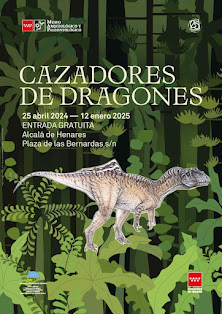Siguiendo con las aportaciones sobre ornitópodos en el XVI Annual Meeting de la European Association of Vertebrate Paleontologist (EAVP), la Comarca de Els Ports también tuvo su sesión con la presentación de una serie de nuevos restos craneales del yacimiento CMP-11 de la Cantera del Mas de la Parreta pertenecientes, al menos, a dos individuos de ornitópodos estiracosternos.
A pesar de que previamente ya se conocía la presencia de estos dos nuevos individuos en este yacimiento, los nuevos datos aportados en este congreso confirman de manera inequívoca al archiconocido estiracosterno Iguanodon bernissartensis como el ornitópodo presente en CMP-11.
A pesar de que previamente ya se conocía la presencia de estos dos nuevos individuos en este yacimiento, los nuevos datos aportados en este congreso confirman de manera inequívoca al archiconocido estiracosterno Iguanodon bernissartensis como el ornitópodo presente en CMP-11.
Aquí va el resumen:
The Barremian Arcillas de Morella Formation (Eastern Spain) has yielded a high diversity of vertebrates. The most representative fossil site of this formation is the Mas de la Parreta quarry (CMP), located at the southwest of the locality of Morella (Castellón province, Spain). The best represented dinosaur group are styracosternan ornithopods that are by far the most abundant dinosaurs throughout the Iberian Lower Cretaceous. To date, three styracosternan species have been recognized: Iguanodon bernissartensis, Mantellisaurus atherfieldensis and Morelladon beltrani. Several individuals of I. bernissartensis have been recovered in di erent sites of CMP being the most common styracosternan in the formation.
CMP-11 is one of the sites inside the CMP in which cranial and postcranial bones of I. bernissartensis have been discovered. Previously, two isolated maxillae have been reported from this site providing new information about the skull anatomy of I. bernissartensis. Here, new cranial bones have been examined for the first time. These bones correspond to the rostral portion of both sutured premaxillae, a second incomplete right premaxilla, a nearly complete dentary, two quadrates and several isolated dentary and maxillary teeth. The presence of two right premaxillae indicates the presence of at least two individuals. These cranial bones can be confidently referred to Iguanodon bernissartensis based on a unique combination of shared characters, as an autapomorphic extensive vertical buttress of the quadrate. This new material corroborates the abundant presence of a form compatible with I. bernissartensis in the Iberian Peninsula that would constitute the southern limit of its current distribution.
-----
Más información:
Más información:
- Referencia: Gasulla, J.M., Escaso, F., Narváez, I., Sanz, J.L. and Ortega, F. New Iguanodon bernissartensis cranial material from the Upper Barremian Mas de la Parreta quarry (Morella formation) in Morella (Spain). XVI Annual Meeting of European Association of Vertebrate Paleontologists, Abstract Book. 77.
- Imagen: Fernando Escaso, en el papel estelar de Gasulla, durante una de las sesiones de exposición de estos restos de I. bernissartensis en el congreso.





























No hay comentarios:
Publicar un comentario